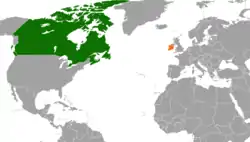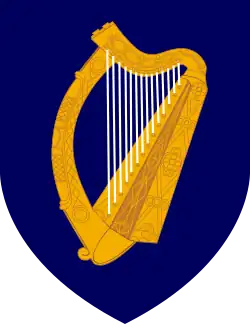Canada–Ireland relations
Canada and the Republic of Ireland enjoy friendly relations, the importance of which centres on the history of Irish migration to Canada and the two countries' shared history as parts of the British Empire. Approximately 4.5 million Canadians claimed to have Irish ancestors (approximately 14% of Canada's population).[1] Both nations are mutual members of the Organisation for Economic Co-operation and Development, United Nations and the World Trade Organization.
 | |
Canada |
Ireland |
|---|---|
History

The first Irish settlers to arrive in Canada came in the 17th century when the French began to arrive in present-day Canada and brought with them Irish soldiers.[2] In the 18th century, Irish fisherman would sail to Newfoundland and Labrador to fish off the coasts and many settled in the province.[2] By 1850, over 500,000 Irish migrants arrived in Canada, though many did continue onwards to the United States.[2]
Before 1922 both Canada and Ireland were part of the British Empire and therefore had no international relations separate from British ones. From 1922 to 1937 the Irish Free State was a Dominion, like Canada, under the British Crown but self-governing. Canada sent its first High Commissioner to Ireland, [John Hall Kelly], in 1929. This at a time when Britain did not allow Canada to have embassies in most states and Britain's representative in Ireland was not allowed to use the title of ambassador. In 1937 Ireland changed its constitution to give itself more complete independence from the United Kingdom, however there was still some ambiguity over the role of the Crown in Irish law. In 1931, after the signing of the Statute of Westminster, Canada became a sovereign and independent nation. In 1939, both nations opened resident diplomatic missions in each other's capitals, respectively.[1]
In 1948 the Taoiseach (prime minister) of Ireland, John A. Costello, was visiting Canada when he announced that Ireland would declare itself a republic. The reason why he chose to make the announcement in Canada is a subject of debate. It may have been that Costello was offended by the behaviour of the Governor General of Canada, Harold Alexander, 1st Earl Alexander of Tunis, who was of Northern Irish descent and who allegedly placed symbols of Northern Ireland, notably a replica of the famous Roaring Meg cannon used in the Siege of Derry, before an affronted Costello at a state dinner. What is certain is that the prior arrangement whereby toasts to the king (symbolising Canada) and the president (representing Ireland) were to be proposed, was broken. Only a toast to the king was proposed, to the fury of the Irish delegation. Shortly afterwards Costello announced the plan to declare the republic. Other explanations for the announcement being made at this time have been offered, including the idea that the change was already planned and an Irish newspaper was about to "break" the story. Whatever the reason the Republic of Ireland Act 1948 soon passed with support from all parties.
In 1986, Canadian Prime Minister Brian Mulroney announced that Canada would contribute up to $10 million over 10 years to Northern Ireland and the Republic of Ireland for economic and social development programs.[3] In recent times Canada has been an active supporter of the Northern Ireland peace process as symbolised by former Canadian Chief of the Defence Staff John de Chastelain heading the Independent International Commission on Decommissioning.
In August 2017, Taoiseach Leo Varadkar came to Canada and joined Canadian Prime Minister Justin Trudeau in the Montréal Pride Parade.[4]
High-level visits
Prime Ministerial visits from Canada to Ireland[5][6][7][8][9][10][11]
- Prime Minister John Diefenbaker (1961)
- Prime Minister Pierre Trudeau (1975)
- Prime Minister Brian Mulroney (1991)
- Prime Minister Jean Chrétien (1999)
- Prime Minister Paul Martin (2005)
- Prime Minister Stephen Harper (2013)
- Prime Minister Justin Trudeau (2017)
Presidential and Prime Ministerial (Taoiseach) visits from Ireland to Canada[12][13][14][15][16][17][18][4]
- Taoiseach John A. Costello (1948)
- President Éamon de Valera (1964)
- Taoiseach Garret FitzGerald (1985)
- President Mary Robinson (1994)
- President Mary McAleese (1998, 2007)
- Taoiseach Bertie Ahern (2005)
- Taoiseach Enda Kenny (2017)
- Taoiseach Leo Varadkar (2017)
Trade
In October 2016, Canada and the European Union (which includes Ireland) signed a free trade agreement known as the "Comprehensive Economic and Trade Agreement".[19] In 2017, total trade between Canada and Ireland amounted to $2.9 billion Canadian dollars.[20] Canada's main exports to Ireland include: chemical products, vehicles and equipment, machine, mechanical and electronic products. Ireland's main exports to Canada include: chemical products, specialized instruments, food and animal based produce.[21]
Resident diplomatic missions

See also
References
- Canadian-Irish Relations
- Irish Canadians
- Irish to Get Canadian Aid
- "Leo Varadkar and Justin Trudeau take part in Montreal Pride Parade". BBC News. Archived from the original on 2022-11-13.
- John Diefenbaker in Ireland
- 1975 - Pierre Trudeau visits Dublin
- "Visit to Ireland by Prime Minister Brian Mulroney". Archived from the original on 2017-01-03. Retrieved 2017-01-02.
- Canadian leader outlines country's links with Ireland
- Martin, world leaders gear up for G-8 summit
- Taoiseach to discuss trade opportunities with Canadian Prime Minister in Dublin
- "Canadian PM Trudeau arrives in Dublin for Irish visit". BBC News. Archived from the original on 2021-12-23.
- Eamon de Valera papers
- Taoiseach North American Visit
- President Mary Robinson at Grosse Île, August, 1994
- President wins her way into heart of Canada
- President begins Canadian visit today
- Aid on the agenda as Taoiseach meets Canadian premier
- Prime Minister Justin Trudeau meets with Irish Taoiseach (Prime Minister) Enda Kenny
- EU and Canada sign free trade agreement
- Canadian Trade and Investment Activity: Canada–Ireland
- Canada International: Ireland
- "Embassy of Canada in Dublin". Archived from the original on 2017-08-21. Retrieved 2017-01-02.
- Embassy of Ireland in Ottawa
